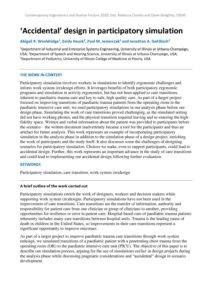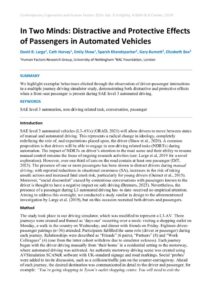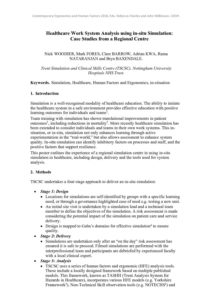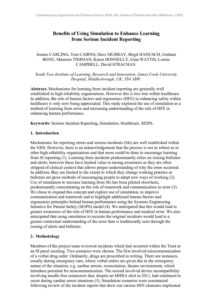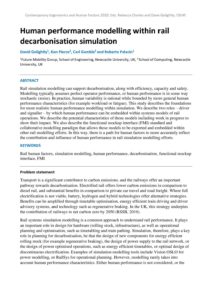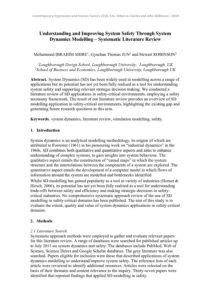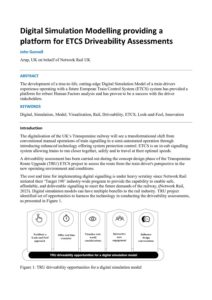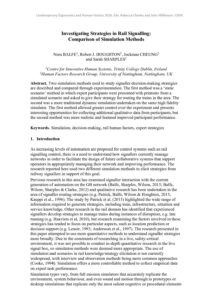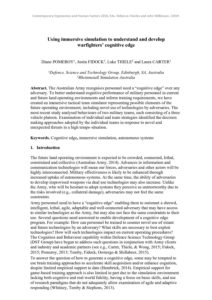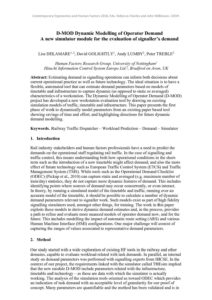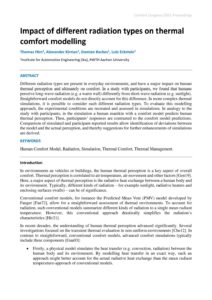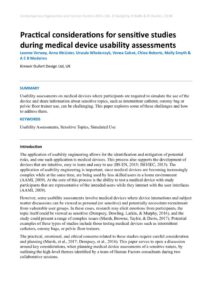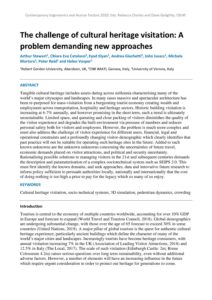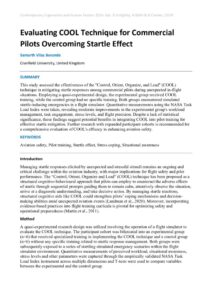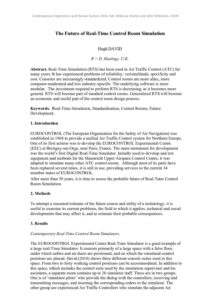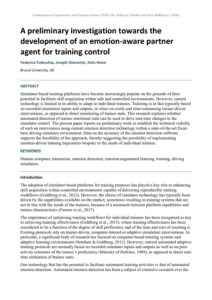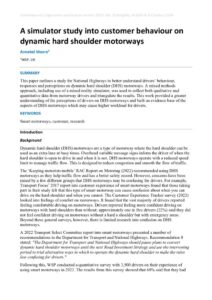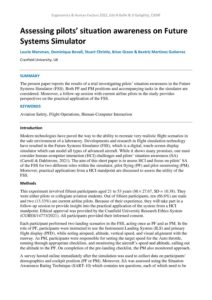Simulation
‘Accidental’ design in participatory simulation
| Document | Author Abigail R. Wooldridge, Emily Heuck, Paul M. Jeziorczak and Jonathan A. Gehlbach |
| Abstract Participatory simulation involves workers in simulations to identify ergonomic challenges and inform work system (re)design efforts. It leverages benefits of both participatory ergonomic programs and simulation in activity ergonomics, but has not been applied to care transitions, inherent to paediatric trauma care and key to safe, high quality care. As part of a larger project focused on improving transitions of paediatric trauma patients from the operating room to the paediatric intensive care unit, we used participatory simulations in our analysis phase before our design phase. Simulating the work of care transitions proved challenging, as the simulated setting did not have working phones, and the physical transition required leaving and re-entering the high-fidelity space. Written and verbal information about the patient was provided to participants before the scenario – the written document inadvertently became a tool for the participants and thus an artefact for future analysis. This work represents an example of incorporating participatory simulation in the analysis phase in addition to the simulation phase of a design project, enriching the work of participants and the study itself. It also discusses some the challenges of designing scenarios for participatory simulation. Choices we make, even to support participants, could lead to accidental design. Further, this work represents an important advance in the study of care transitions and could lead to implementing our accidental design following further evaluation. |
In Two Minds: Distractive and Protective Effects of Passengers in Automated Vehicles
| Document | Author David R. Large, Cath Harvey, Emily Shaw, Sparsh Khandeparker, Gary Burnett, Elizabeth Box |
| Abstract We highlight exemplar behaviours elicited through the observation of driver-passenger interactions in a multiple journey driving simulator study, demonstrating both distractive and protective effects when a front-seat passenger is present during SAE level 3 automated driving. |
Healthcare Work System Analysis using in-situ Simulation: Case Studies from a Regional Centre
| Document | Author Nick WOODIER, Mark FORES, Clare BARROW, Adrian KWA, Rama NATARANJAN and Bryn BAXENDALE |
| Abstract |
Benefits of Using Simulation to Enhance Learning from Serious Incident Reporting
| Document | Author Joanne CARLING, Tom CAIRNS, Dave MURRAY, Birgit HANUSCH, Graham BONE, Maureen TIERNAN, Karen DONNELLY, Gina WATTIS, Louise CAMPBELL, David STRACHAN |
| Abstract Mechanisms for learning from incident reporting are generally well established in high reliability organisations. However this is less true within healthcare. In addition, the role of human factors and ergonomics (HFE) in enhancing safety within healthcare is only now being appreciated. This study explored the use of simulation as a method of learning from error and increasing understanding of the role of HFE in enhancing human performance. |
Human performance modelling within rail decarbonisation simulation
| Document | Author David Golightly, Ken Pierce, Carl Gamble and Roberto Palacin |
| Abstract Rail simulation modelling can support decarbonisation, along with efficiency, capacity and safety. Modelling typically assumes perfect operator performance, or human performance is in some way stochastic (noise). In practice, human variability is rational while bounded by more general human performance characteristics (for example workload or fatigue). This study describes the foundations for more realistic human performance modelling within simulation. We describe two roles – driver and signaller – by which human performance can be embedded within systems models of rail operations. We describe the potential characteristics of those models including work in progress to show their impact. We also describe the functional mockup interface (FMI) standard and collaborative modelling paradigm that allows these models to be exported and embedded within other rail modelling efforts. In this way, there is a path for human factors to more accurately reflect the contribution and influence of human performance in rail simulation modelling efforts. |
Understanding and Improving System Safety Through System Dynamics Modelling – Systematic Literature Review
| Document | Author Mohammed IBRAHIM SHIRE, Gyuchan Thomas JUN and Stewart ROBINSON |
| Abstract System Dynamics (SD) has been widely used in modelling across a range of applications but its potential has not yet been fully realised as a tool for understanding system safety and supporting relevant strategic decision making. We conducted a literature review of SD applications in safety-critical environments, employing a safety taxonomy framework. The result of our literature review provides an overview of SD modelling application in safety-critical environments, highlighting the existing gap and generating future research questions in this area. |
Digital Simulation Modelling providing a platform for ETCS Driveability Assessments
| Document | Author John Gunnell |
| Abstract The development of a true-to-life, cutting-edge Digital Simulation Model of a train drivers experience operating with a future European Train Control System (ETCS) system has provided a platform for robust Human Factors analysis and has proven to be a success with the driver stakeholders. |
Investigating Strategies in Rail Signalling: Comparison of Simulation Methods
| Document | Author Nora BALFE, Robert J. HOUGHTON, Jockman CHEUNG and Sarah SHARPLES |
| Abstract Two simulation methods used to study signaller decision-making strategies are described and compared through experimentation. The first method was a ‘static scenario’ method in which expert participants were presented with printouts from a simulated scenario and asked to give their strategy for routing the trains in the area. The second was a more traditional dynamic simulation undertaken on the same high fidelity simulator. The first method allowed greater control over the experiment and presents interesting opportunities for collecting additional qualitative data from participants, but the second method was more realistic and featured improved participant performance. |
Using immersive simulation to understand and develop warfighters’ cognitive edge
| Document | Author Diane POMEROY, Justin FIDOCK, Luke THIELE and Laura CARTER |
| Abstract The Australian Army recognises personnel need a “cognitive edge” over any adversary. To better understand cognitive performance of military personnel in current and future land operating environments and inform training requirements, we have created an immersive tactical team simulator representing possible elements of the future operating environment, including novel use of technologies by adversaries. The most recent study analysed behaviours of two military teams, each consisting of a three vehicle platoon. Examination of individual and team strategies identified the decision making approaches adopted by the individual teams in response to novel and unexpected threats in a high tempo situation. |
D-MOD Dynamic Modelling of Operator Demand – A new simulator module for the evaluation of signaller’s demand
| Document | Author Lise DELAMARE, David GOLIGHTLY, Andy LUMBY, Peter TREBLE |
| Abstract Estimating demand in signalling operations can inform both decisions about current operational practice as well as future technology. The ideal situation is to have a flexible, automated tool that can estimate demand parameters based on models of timetable and infrastructure to capture dynamic (as opposed to static or averaged) characteristics of a workstation. The Dynamic Modelling of Operator Demand (D-MOD) project has developed a new workstation evaluation tool by drawing on existing simulation models of traffic, timetable and infrastructure. This paper presents the first phase of work to dynamically model parameters from an existing paper based tool showing savings of time and effort, and highlighting directions for future dynamic demand modelling. |
Impact of different radiation types on thermal comfort modelling
Practical considerations for sensitive studies during medical device usability assessments
| Document | Author Leanne Verwey, Anna McLister, Urszula Wlodarczyk, Venea Calcot, Chloe Roberts, Molly Smyth & A C B Medeiros |
| Abstract Usability assessments on medical devices where participants are required to simulate the use of the device and share information about sensitive topics, such as intermittent catheter, ostomy bag or pelvic floor trainer use, can be challenging. This paper explores some of these challenges and how to address them. |
The challenge of cultural heritage visitation: A problem demanding new approaches
| Document | Author Arthur Stewart, Chiara Eva Catalano, Eyad Elyan, Andrea Giachetti, John Isaacs, Michela Mortara, Peter Reid and Helen Vosper |
| Abstract Tangible cultural heritage includes assets dating across millennia characterising many of the world’s major cityscapes and landscapes. In many cases massive and spectacular architecture has been re-purposed for mass-visitation from a burgeoning tourist economy creating wealth and employment across transportation, hospitality and heritage sectors. Historic building visitation is increasing at 6-7% annually, and however promising in the short term, such a trend is ultimately unsustainable. Limited space, and queueing and close packing of visitors diminishes the quality of the visitor experience and degrades the built environment via pressure of numbers and reduces personal safety both for visitors and employees. However, the problem is much more complex and must also address the challenge of visitor experience for different users, financial, legal and operational constraints and a profoundly changing visitor-demographic which clearly identifies that past practice will not be suitable for operating such heritage sites in the future. Added to such known unknowns are the unknown unknowns concerning the uncertainties of future travel, economic demands placed on visitor attractions, and political and security uncertainty. Rationalising possible solutions to managing visitors in the 21st and subsequent centuries demands the description and parameterisation of a complex-sociotechnical system such as SEIPS 2.0. This must first identify the known domains, and seek approaches, data and innovative future research to inform policy sufficient to persuade authorities locally, nationally and internationally that the cost of doing nothing is too high a price to pay for the legacy which so many of us enjoy. |
Exploratory study of virtual reality flight training device for upset prevention and recovery training
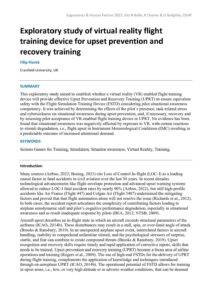
| Document
Insert here |
Author Filip Florek |
| Abstract This exploratory study aimed to establish whether a virtual reality (VR) enabled flight training device will provide effective Upset Prevention and Recovery Training (UPRT) to ensure equivalent safety with the Flight Simulation Training Device (FSTD) considering pilot situational awareness competency. It was achieved by determining the effects of the pilot’s presence, task-related stress and cybersickness on situational awareness during upset prevention, and, if necessary, recovery and by assessing pilot acceptance of VR-enabled flight training device in UPRT. No evidence has been found that situational awareness was negatively affected by exposure to VR, with certain reactions to stimuli degradation, i.e., flight upset in Instrument Meteorological Conditions (IMC) resulting in a predictable outcome of increased attentional demand. |
Evaluating COOL Technique for Commercial Pilots Overcoming Startle Effect
| Document | Author Samarth Vilas Burande |
| Abstract This study assessed the effectiveness of the "Control, Orient, Organize, and Lead" (COOL) technique in mitigating startle responses among commercial pilots during unexpected in-flight situations. Employing a quasi-experimental design, the experimental group received COOL training, while the control group had no specific training. Both groups encountered simulated startle-inducing emergencies in a flight simulator. Quantitative measurements using the NASA Task Load Index were taken, revealing moderate improvements in the experimental group's workload management, task engagement, stress levels, and flight precision. Despite a lack of statistical significance, these findings suggest potential benefits in integrating COOL into pilot training for effective startle mitigation. Further research with expanded participant cohorts is recommended for a comprehensive evaluation of COOL's efficacy in enhancing aviation safety. |
The Future of Real-Time Control Room Simulation
| Document | Author Hugh DAVID |
| Abstract Real-Time Simulation (RTS) has been used in Air Traffic Control (ATC) for many years. It has experienced problems of reliability, verisimilitude, specificity and cost. Consoles are increasingly standardized. Control rooms are more alike, more computer-moderated and less industry-specific. The underlying software is more modular. The investment required to perform RTS is decreasing, as it becomes more general. RTS will become part of standard control rooms. Generalized RTS will become an economic and useful part of the control room design process. |
A preliminary investigation towards the development of an emotion-aware partner agent for training control
| Document | Author Federico Colecchia, Joseph Giacomin, Kate Hone |
| Abstract Simulator-based training platforms have become increasingly popular on the grounds of their potential to facilitate skill acquisition within safe and controlled environments. However, current technology is limited in its ability to adapt to individual trainees. Tailoring is in fact typically based on recorded simulation inputs and outputs, or relies on costly and time-consuming trainer-driven interventions, as opposed to direct monitoring of trainee state. This research explores whether automated detection of trainee emotional state can be used to drive real-time changes to the simulator control. The present paper reports on preliminary work to establish the technical viability of such an intervention using current emotion detection technology within a state-of-the-art fixed-base driving simulator environment. Data on the accuracy of the emotion detection software supports the feasibility of the approach, thereby suggesting the possibility of implementing emotion-driven training trajectories bespoke to the needs of individual trainees. |
A simulator study into customer behaviour on dynamic hard shoulder motorways
| Document | Author Annabel Moore |
| Abstract This paper outlines a study for National Highways to better understand drivers’ behaviour, responses and perceptions on dynamic hard shoulder (DHS) motorways. A mixed methods approach, including use of a mixed reality simulator, was used to collect both qualitative and quantitative data from motorway drivers and triangulate the results. This work provided a greater understanding of the perceptions of drivers on DHS motorways and built an evidence base of the aspects of DHS motorways which may cause higher workload for drivers. |
Assessing pilots’ situation awareness on Future Systems Simulator
| Document | Author Laurie Marsman, Dominique Bovell, Stuart Christie, Brian Green & Beatriz Martinez Gutierrez |
| Abstract The present paper reports the results of a trial investigating pilots’ situation awareness in the Future Systems Simulator (FSS). Both PF and PM positions and accompanying tasks in the simulator are considered. Moreover, a follow-up session with current airline pilots in the study provides perspectives on the practical application of the FSS. |

